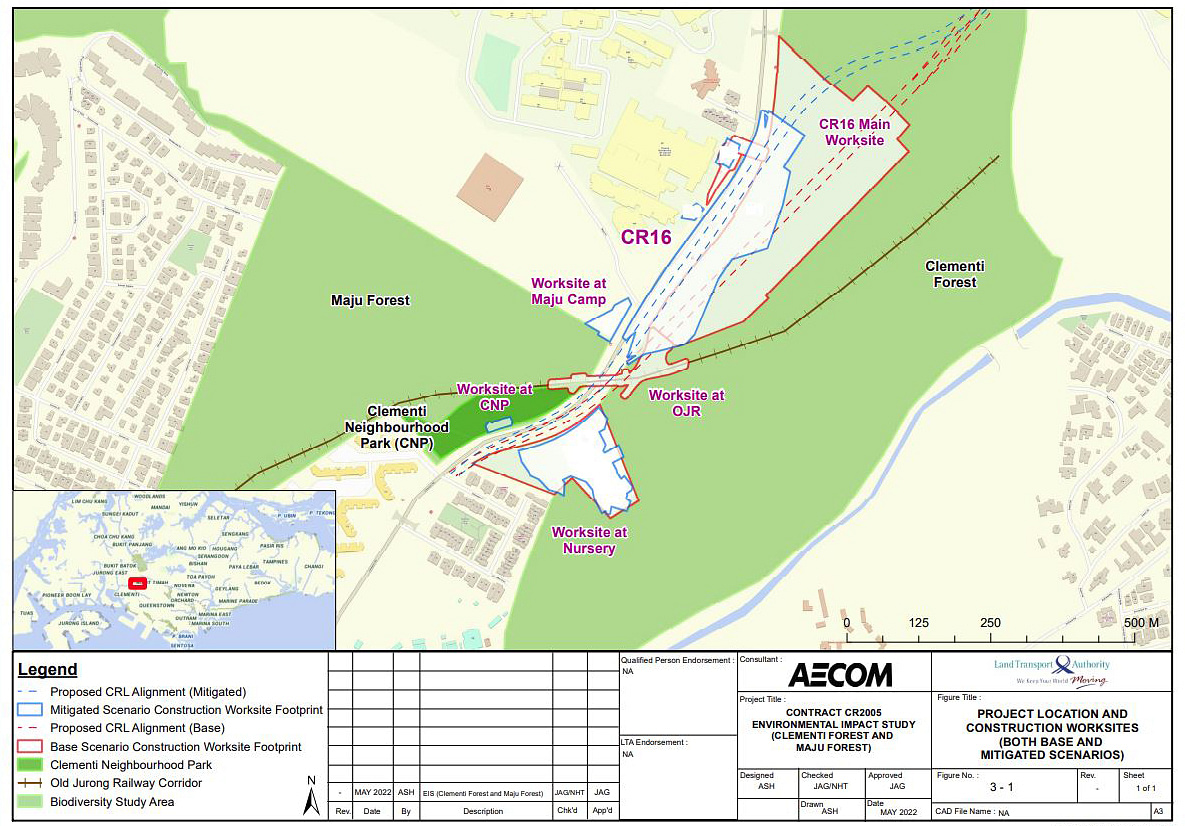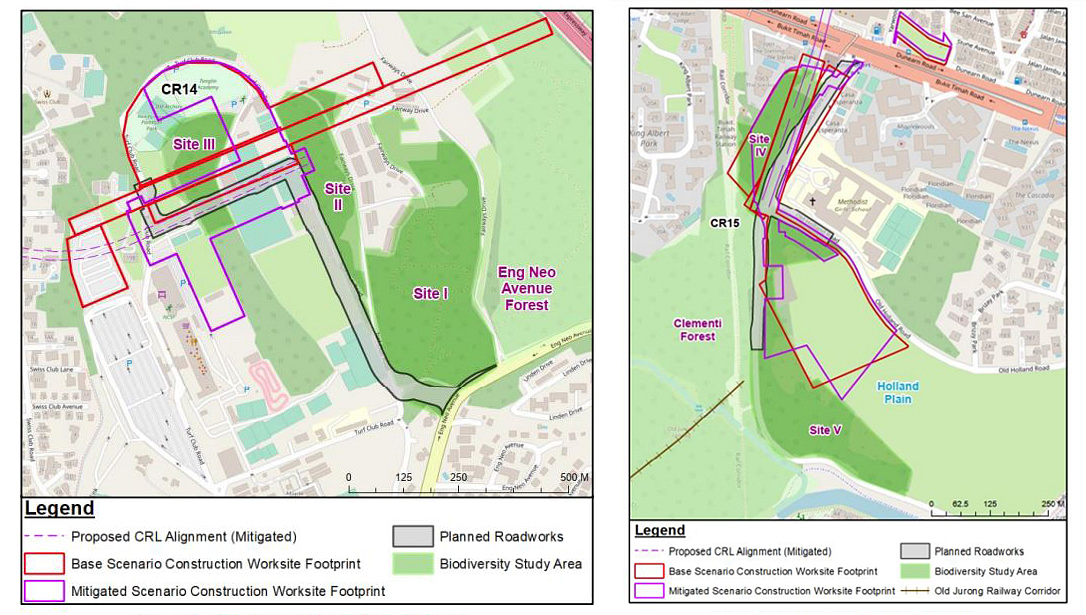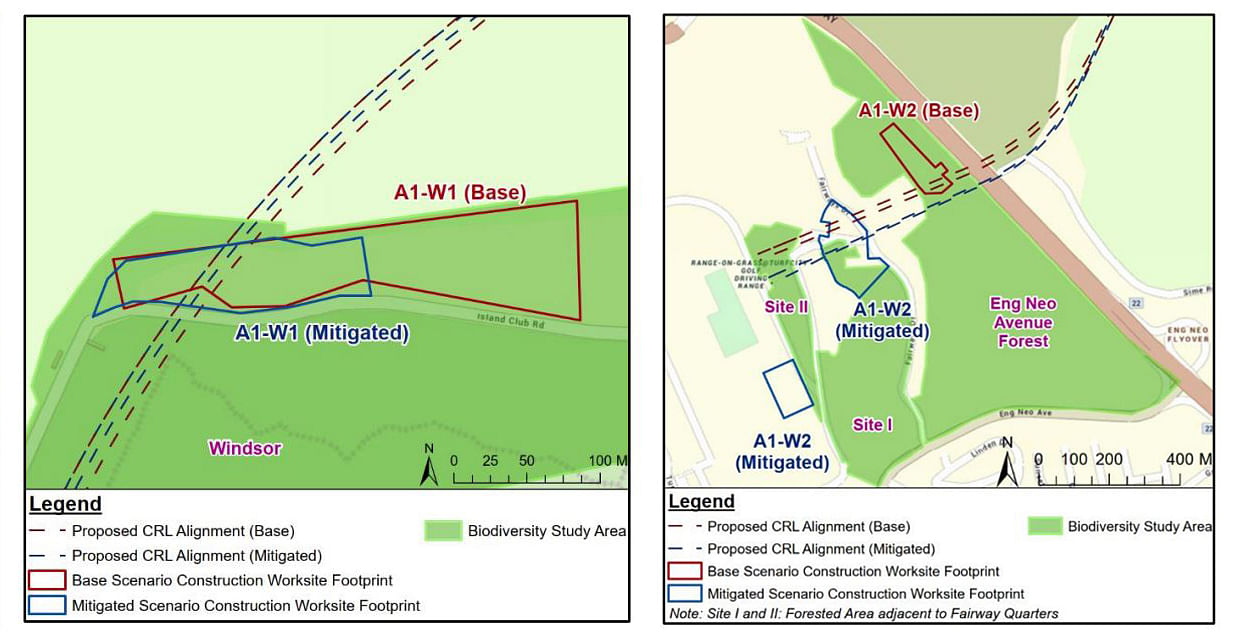Cross Island Line phase 2 could have major impact on nearby forests: Study
SINGAPORE - Initial plans to build the future Maju Cross Island Line (CRL) station within the boundaries of Clementi Forest were scrapped in favour of its current planned location underneath Clementi Road.
This decision was made to reduce the amount of forested land consumed for phase two of the upcoming rail line, an environmental impact study released on Monday revealed.
The tunnels leading to Maju station from King Albert Park station were also realigned to limit the impact on what is an ecologically important area teeming with wildlife.
Meanwhile, CRL construction sites that are close to ecologically sensitive areas such as Clementi Forest and forests near the Central Catchment Nature Reserve will be reduced in size, or relocated.
These are some of the key mitigation strategies outlined in the study released by the Land Transport Authority (LTA) on the construction and operation of the CRL stations between Bright Hill and Clementi.
Without these measures, phase two of the CRL could lead to the permanent loss of habitats for critically endangered wildlife and fragmentation of ecologically connected areas nearby, the study by infrastructure consulting firm Aecom found.
But even with these steps, the nearly 2,000-page study found that the CRL could still have a major environmental impact on several forested areas near Eng Neo Avenue Forest, Clementi Forest and Windsor due to irreversible habitat loss.
The 15km CRL phase two, which will comprise six stations from Turf City to Jurong Lake District, will provide greater public transport access to areas in the west and open by 2032, with construction expected to start in 2023.
The Aecom study for CRL phase two is split into three reports, covering Windsor and Eng Neo Avenue Forest near the Central Catchment Nature Reserve, Turf City and Holland Plain, as well as Clementi and Maju forests.
Both direct impacts to biodiversity, as well as indirect impacts such as noise and vibration, were assessed based on the consequence and likelihood of its occurrence.
"Moderate" impacts are those that are reversible, long-term and of medium magnitude whereas "major" impacts have high magnitude and are irreversible.
The study concluded that while CRL phase two could still have moderate to major impacts on nearby forests, this can be adequately managed through measures such as locating worksites outside areas with high biodiversity conservation value.
Other steps proposed include rope bridges for wildlife to traverse green space, avoiding tree felling during peak bird breeding season from May to July and installing water-filled barriers along roads to minimise roadkill.
Clementi Forest and Maju Forest

The LTA will reduce the size of the Maju station worksite, which straddles Maju Forest and Clementi Forest, from about 124,058 sq m to 65,429 sq m. Doing so will cut down on land taken from the forests.
The report had noted that animals critically endangered globally such as the straw-headed bulbul and the Sunda pangolin are among 57 of 435 species of flora and fauna with conservation significance in Maju Forest.
Having a smaller worksite will avoid loss of some habitat or vegetation during site clearance, the report said.
A planned pedestrian walkway to the Maju station worksite along Old Jurong Railway Corridor will also be scrapped to promote ecological connectivity, it added.
Meanwhile, Clementi Forest, which recorded 70 species of conservation significance, was identified as a key site for wildlife to seek refuge in.
As streams increasingly become uncommon habitats in Singapore, the hydrology of Clementi Forest will be preserved during development to ensure there are no impacts downstream, the report said.
Turf City and Holland Plain

Likewise, the boundary of the worksites for the future Turf City and King Albert Park stations will be shifted to reduce encroachment into nearby wildlife habitats.
According to the report, the construction footprint of Turf City will be reduced from 158,000 sq m to 105,500 sq m while King Albert Park will be cut from 106,000 sq m to 82,000 sq m.
This will help minimise impact on five sites near forested areas, comprising seven habitat types ranging from marshes to secondary forest, and hundreds of flora and fauna species.
One of these sites near the King Albert Park worksite holds the last remaining patches of a variety of native pitcher plants outside nature reserves in Singapore. This site has large populations of up to four native Nepenthes pitcher plant species, of which two are nationally threatened and one is a rare native hybrid, the report said.
While shrinking the Turf City worksite would limit habitat degradation for sites near Eng Neo Avenue Forest, major habitat loss can still occur during the construction phase of King Albert Park station even with these changes, the report added.
Windsor and Eng Neo Avenue forest

The authorities had said in 2021 that the worksite in Windsor near the Central Catchment Nature Reserve will be more than halved from 15,000 sq m to 7,000 sq m.
Part of this new site will occupy the grounds of Singapore Island Country Club to reduce impact on animals and plants, including the nationally endangered Sunda slow loris and critically endangered Raffles' banded langur.
Another worksite in Eng Neo Avenue forest will also be shifted outside the forest, the report noted.
Naturalists and conservationists welcomed the adjustments made to the CRL, which addressed some of the concerns raised during engagement sessions.
Dr Shawn Lum, president of Nature Society (Singapore), said the group has met regularly with the project team and senior management of LTA to discuss CRL works since 2013. It has helped fine-tune plans such as shifting worksites to avoid building across documented routes for wildlife, he added.
Environmental consultant Tony O'Dempsey said the LTA had relocated the planned launch site for tunnelling works near Eng Neo Avenue Forest following thorough surveys.
"While the final site brings with it extra engineering challenges, the potential impact to ecologically sensitive locations was massively reduced," he added.
Mr Sankar Ananthanarayanan, president of the Herpetological Society of Singapore, said the study has highlighted the need for mitigation measures to reduce the CRL's impact. Still, it is worrying that moderate to major impact is anticipated for Windsor, despite such measures, he added.
Members of the Public can view the study reports on LTA's website until Nov 7 and submit feedback at this online form.

No comments
Share your thoughts! Tell us your name and class for a gift (: